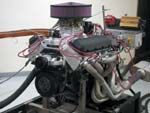
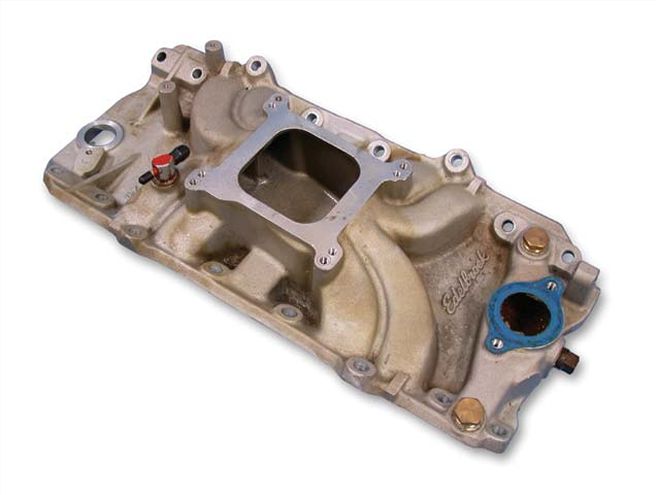 Torker II 2-0
Torker II 2-0
What started out as a simple manifold comparo turned into three days and over 100 dyno pulls worth of newfound questions and answers—or theories, anyway. That's the way it always is on the dyno, and we've found that when it comes to predicting power trends, you can never say "always." That's why we've launched this all-new tech series called Every Trick in the Book. Stick around for months to come as we hammer commonly held beliefs about every possible widget crucial to speed and our general well-being as gearheads.
This time, we'll rank the available Edelbrock intakes and find out that the difference between the wrong combo and the right one could cost 30 hp and 60 lb-ft—even on a very mild engine. Don't let that be you.
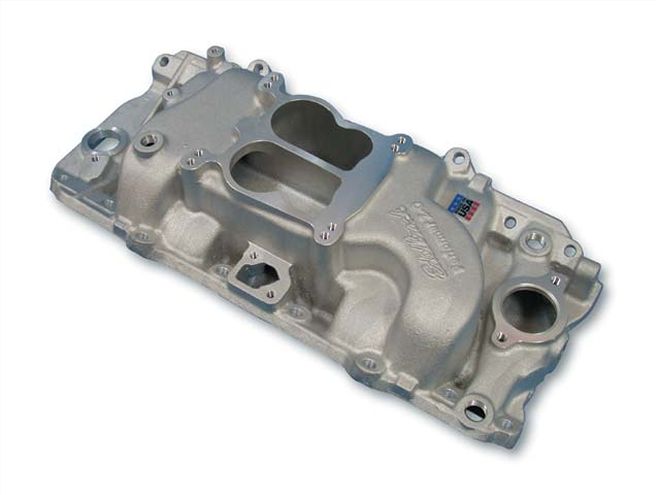 Performer 2-O
Performer 2-O
The Tool
It's a Chevy again, but to save you from the tedium of yet another Mouse motor, our new flog unit is a GM Performance Parts ZZ454 crate engine, PN 12498777. The ZZ iteration seems oddly under-advertised; it's the same as the 454 H.O. crate engine, but rather than the 990-casting iron rectangle-port heads, the ZZ uses the GM Performance Parts aluminum heads that come on the familiar ZZ502 crate engine. These have "roval" or "rectoval" intake ports that are more elongated than conventional rectangle-ports but not as round as factory oval-ports, and they look more than coincidentally like Edelbrock Performer RPM heads. While the iron-head 454 H.O. is advertised at 8.75:1 compression with 118cc chambers, the ZZ454's 110cc chambers are said to deliver 9.6:1 compression. Since the short-blocks are identical, our math points to compression closer to 9.25:1.
The guts include a Gen VI block with four-bolt mains, a forged crank and pistons, and a mild hydraulic roller cam: 211/230 duration at 0.050 with 0.510/0.540 lift. At a $5,560 street price, the ZZ454 sells for about $730 more than its iron-head brother.
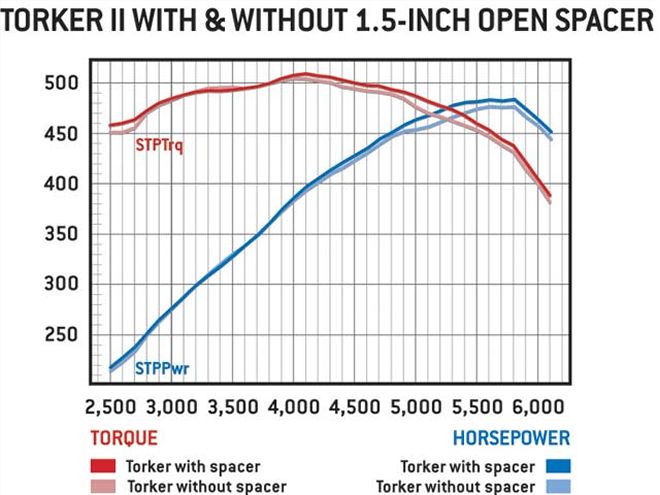 Victor Jr.
Victor Jr.
The Baseline Test
The GM ZZ454 comes complete with a dual-plane intake, a water pump, a damper, an oil pan, and an auto-trans flexplate. For our baseline dyno testing, we replaced the mechanical water pump with an electric one from CSI and dropped in a PerTronix HEI distributor. Several carbs were tried, but the default carburetor for the bulk of the testing is a Holley 850 double-pumper with JET Performance Products' Stage 3 blueprinting that includes inspection of the circuits and gasket surfaces, a milled choke horn, radiused venturi openings, JET custom boosters, high-flow needle-and-seats, and custom calibration for the intended application.
Until we get to the extensive exhaust testing, the headers will be Hooker PN 2213 coated Super Competition units for a '64-'67 Chevelle with 2-inch primaries, 34-inch tubes, and 3.5-inch collectors. We ran them with 14-inch extensions and 3-inch Flowmaster mufflers.
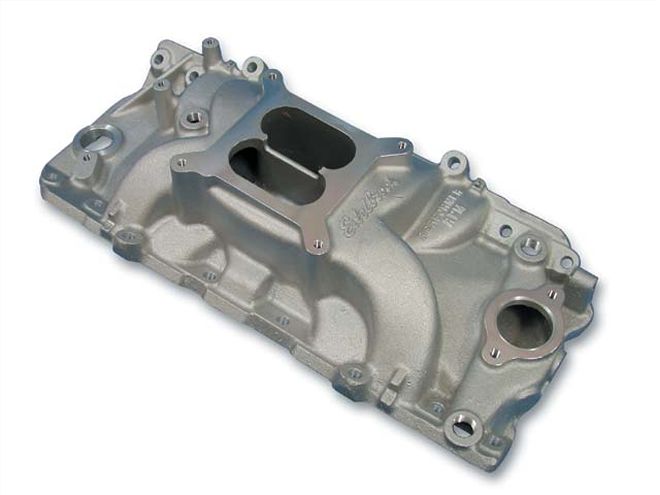 Performer RPM
Performer RPM
Our tune-up runs found the most powerful total timing advance to be 39 degrees, and the carb was set with its 73/86 jets, a 3.5 power valve in the front, and a plugged secondary valve. In this configuration, Westech's Superflow 901 read an STP-corrected 528 lb-ft at 4,000 rpm and 489 hp at 5,700 rpm. It will become our life's mission to step that up.
The Edelbrock Torker II is an older design intended mostly for Corvettes with low hood lines, so it is the squattiest manifold we tested and has a very small plenum—perhaps too small, even for our Rat's tiny cam. Carb size did not seem to affect the Torker's power curve, so we stuck with the 850-cfm JET-tuned carb, then played with carb spacers. A 1.5-inch-tall tapered four-hole spacer killed power badly from 3,000 to 5,200 rpm, probably because it straightened out the flow from the carb, and with this short manifold, rammed it into the plenum floor. More evidence that the plenum wasn't big enough was that a 1.5-inch open carb spacer delivered the best average power from the Torker II.
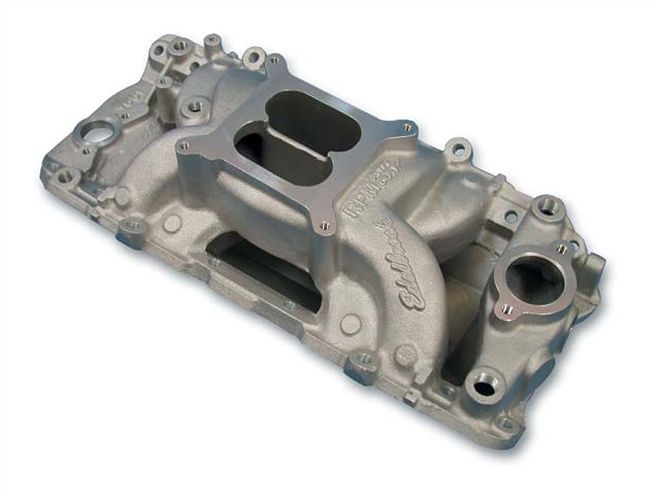 RPM Air-Gap
RPM Air-Gap
We ultimately made the Torker's peak and average power numbers match those of the Performer, but it's our opinion that the Performer would deliver better all-around driveability, so the Torker II falls to last choice for this particular engine. However, if you've got a bigger cam in a car with low hood clearance, the Torker might be for you.
Performers are basic dual-planes that are often smog-legal and usually the lowest-cost Edelbrock intake for any given engine. For years they were the choice for mild engines such as our ZZ454, but they've been ousted by Edelbrock's more modern dual-planes.
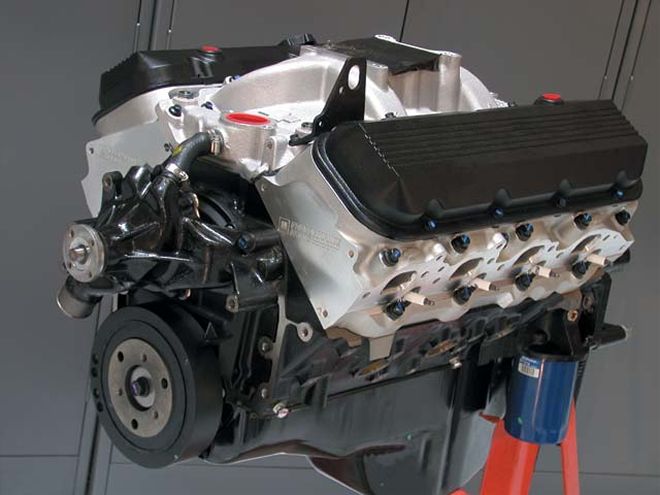 You can buy a GM ZZ454 big-block for about $5,560, complete from intake to oil pan. Then you can read HOT ROD for the next several months to learn how to hop it up.
You can buy a GM ZZ454 big-block for about $5,560, complete from intake to oil pan. Then you can read HOT ROD for the next several months to learn how to hop it up.
While the Performer 2-O (the 2-R is for rectangle-port heads) made more power than the Torker II up to 4,500 rpm and then matched it clear through the rpm range, it was still obvious that the Performer's airflow was limited: it delivered peak torque 800-rpm lower than any other manifold in the test. Not that low-end torque is bad, but the other dual-planes matched the Performer below 3,300 and then kept on making more power above 3,300. A 1.5-inch tapered combination spacer helped the Performer make more power at every point in the plot; so did a 1.5-inch open spacer, which beat the tapered four-hole just a tiny bit.
A Performer intake would be best suited to a big-block with an even smaller camshaft, less cubes, or stock heads that don't breathe as well as our ZZ454's.
In other dyno tests we've run with cams in the neighborhood of 248-at-0.050 to 268-at-0.050, the Victor made 5-15 more peak horsepower than a high-rise dual-plane at the cost of about the same torque down low. The same happened here, but with this small 211/230 cam, the Victor wasn't ideal.
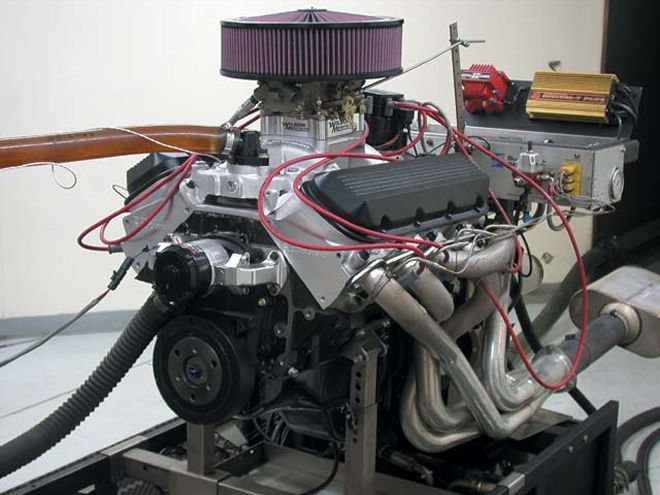 Throughout the manifold testing, the 454 used a Meziere electric water pump, Hooker headers, and Flowmaster mufflers. Come back next month to see how K&N filters stacked up.
Throughout the manifold testing, the 454 used a Meziere electric water pump, Hooker headers, and Flowmaster mufflers. Come back next month to see how K&N filters stacked up.
In fact, the Victor posed an interesting tuning situation: With the JET 850 carb, it delivered the least overall grunt of any manifold we tried. An open carb spacer made it even weaker, yet a 1-inch four-holer added 30 lb-ft in some places! It seemed the large plenum of the Victor Jr. did not deliver a strong enough signal to pull fuel from the annular boosters in the JET carb. The four-hole spacer helped, but not enough.
Oddly, our solution was a bigger carb; a Holley 950HP with dogleg boosters made the best power with the Victor manifold, and while the JET 850 on the Victor was very sensitive to spacers, the Holley 950 almost didn't notice them at all. We also tried the 950HP on other manifolds and it did not make significantly different power than the JET 850.
The moral is that we had too much intake and not enough engine. But we rated the Victor Jr. above the Torker and Performer because it made more average power once we dialed in the tune-up, and it gives you more room to grow into a bigger cam.
The Performer RPM 2-O and the RPM Q-Jet are identical except the carb flange on the latter is opened up to accept the larger secondary throttle blades of a Rochester Quadrajet carb. We tested both versions, thinking that the added plenum volume of the Q-Jet version might make more power even with a square-bore Holley-type carb. If it had, we'd be heros for discovering a speed secret. We weren't heros. The manifolds performed identically no matter what we tried, so the numbers here reflect those we collected using the regular Performer RPM.
The RPM manifolds are Edelbrock's high-rise dual-planes, adding only 3/8 inch of height above the big-block Performer intakes, but using more modern plenum and runner designs to deliver significantly better power. In this test, the RPM intake murdered the Performer by 29 hp and 20 lb-ft, so clearly, the $21 difference in price is well worth it. The graph shows that the RPM delivers stronger power at the low and midrange, and therefore has more average power then the single-plane Victor Jr.

The data in the chart above also shows that our exercise with carb spacers delivered less impressive gains with the RPM than with other intakes, revealing that the RPM was closer to ideal to begin with. However, we did find the best average power by using a 1.5-inch-tall open spacer, and those numbers are reflected in the chart.
The final test verified our longstanding belief: The RPM Air-Gap is the single best all-around street/strip manifold you can buy. We've seen it time and again on engines of various makes, and while we have witnessed applications too wild for an Air-Gap, we've never seen one too mild. On fairly radical pump-gas engines, the Air-Gap usually delivers enough torque increase to more than make up for a slight loss of horsepower as compared to, say, a Victor Jr. single-plane. Flowmaster recently tested a GM ZZ572/620 crate engine, replacing the factory single-plane with an Air-Gap 2-R; the engine gained 65 lb-ft at 2,000 rpm and only gave up 14 hp at peak! The effect on average from 2,000 to 6,000 rpm was minimal—it just skewed the power curve much lower.
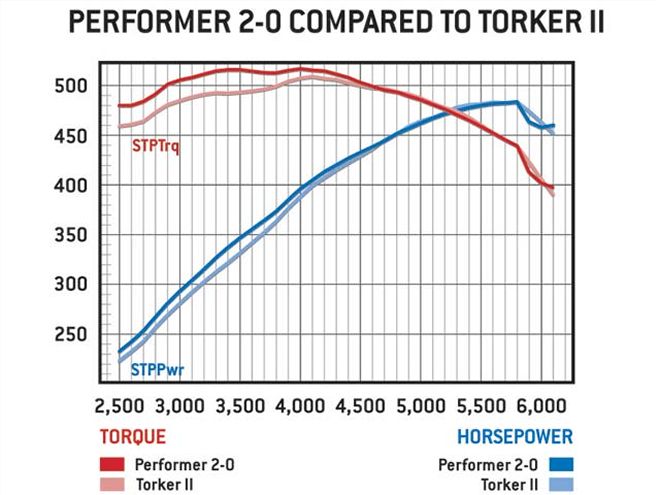
In our less drastic example, the RPM Air-Gap slaughtered every other manifold in the test by every measure, with the exception of the plain RPM manifold, which was only a few numbers behind the Air-Gap. We think that the ZZ454 setup represents the threshold at which the Air-Gap price is either worth it or not. If your engine is milder than this, you probably won't lose much power by saving the $38 difference between the Air-Gap and the regular RPM. But if your engine is a little more radical than the ZZ454, we'd go Air-Gap every time. However, Edelbrock warns that it's too tall to fit under the stock hoods of Corvettes, '64-'67 Chevelles, and '67-'81 Camaros.
As far as dyno tuning goes, none of the four-hole or four-hole tapered-combo spacers we tried helped the Air-Gap, and the taller they got, the more bottom-end power they gave up. Curiously, with the 850 carb, a 1.5-inch open spacer helped make power above 4,100 rpm and did not give up anything down low. With the 950 carb, the open spacer helped less up top, but gave up power down low. Which is why you can never say always when it comes to speed parts.
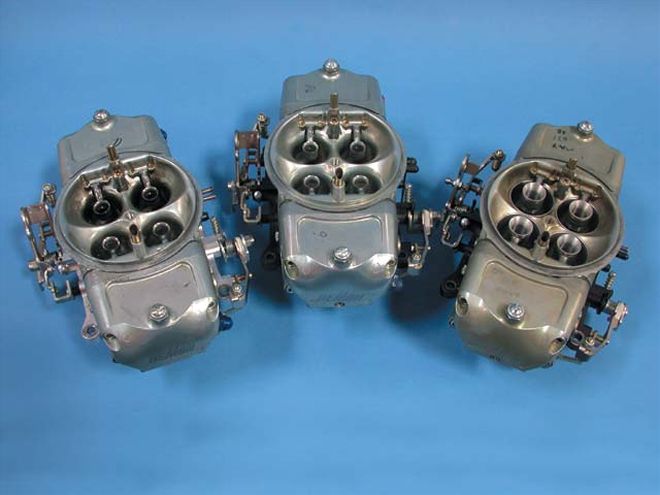
Carb Comparo
Once we'd identified the Air-Gap manifold with the 1.5-inch open spacer as our favorite combo for this engine, we wanted to see if there was a more perfect carburetor. We'd already tried both a JET 850 and a Holley 950HP and found virtually no difference, so we broke out the Demons.
We ran a 750 Mighty Demon, an 850 Mighty Demon, and a 975 Race Demon. Same deal: no difference. We'll often see a slight variance in peak power with larger carburetors, but this engine was not making enough power to need a bigger carb, and any differences in the atomization qualities of the various carb brands did not show up in the power curve this time. Since the 750-cfm carb is not limiting the performance on the dyno, that tends to indicate that it would be best for overall driveability and acceleration since it has the smallest throttle area.
Torker II 2-O PN: 5061Price at {{{Summit}}} Racing: $199.95 Design: Low-rise single-planeHeight: 3.{{{825}}} inches Out of the BoxAfter Dyno TuningNet Gain Peak hp477 @ 5,{{{600}}}484 @ 5,6007 Peak lb-ft{{{505}}} @ 4,000510 @ 4,1005 Average hp3813854 Average lb-ft4784835 Performer 2-O PN: 2161Price at Summit Racing: $172.88 Design: Low-rise dual-planeHeight: 4.85 inches Out of the BoxAfter Dyno TuningNet Gain Peak hp467 @ 5,600484 @ 5,80017 Peak lb-ft510 @ 3,{{{300}}}517 @ 3,5007 Average hp38039010 Average lb-ft48049010 Victor Jr. 454-O PN:2904Price at Summit Racing: $215.95 Design: High-rise single-planeHeight: 5.{{{90}}} inches Out of the BoxAfter Dyno TuningNet Gain Peak hp479 @ 5,800511 @ 5,80032 Peak lb-ft478 @ 4,400518 @ 4,{{{200}}}40 Average hp36639630 Average lb-ft45749538 Performer RPM 2-O PN:RPM 2-O, 7161; RPM Q-Jet, 7164Price at Summit Racing: RPM 2-O, $193.88; RPM Q-Jet, $203.95 Design: High-rise dual-plane Height: 5.225 inches Out of the BoxAfter Dyno TuningNet Gain Peak hp496 @ 5,700504 @ 5,6008 Peak lb-ft530 @ 4,100535 @ 4,1005 Average hp3984035 Average lb-ft5005066 Winner! RPM Air-Gap PN:7561Price at Summit Racing: $231.95 Design: High-rise dual-plane with air passage under runnersHeight: 5.225 inches Out of the BoxAfter Dyno TuningNet Gain Peak hp503 @ 5,700508 @ 5,6005 Peak lb-ft539 @ 4,100540 @ 4,1001 Average hp4034063 Average lb-ft5065104